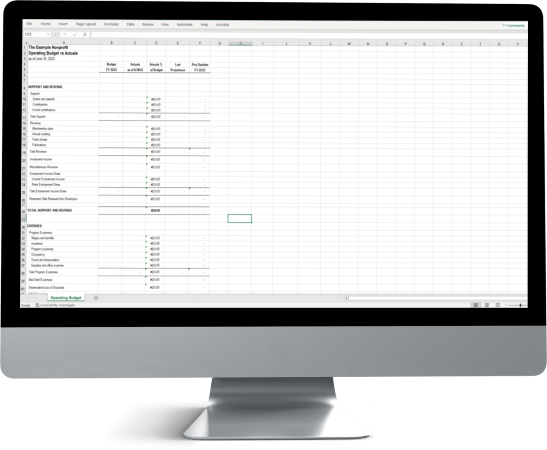Creating and managing your nonprofit’s budget probably isn’t a favorite annual task. Though budgeting may feel tedious or even overwhelming, having a clearly established budget plays a key role in your nonprofit’s ability to successfully execute its mission.
A budget provides your organization with a financial roadmap to ensure resources are being allocated effectively, cash flow management, credibility with key stakeholders and much more.
Before Creating Your Nonprofit's Budget
Before kickstarting the budgeting process, a schedule should be created, leaving enough time for budget research, review, feedback and approval. Get ready to document everything along the way, as this ensures transparency across your organization. Good documentation also keeps everyone accountable for their responsibilities and deadlines.
It’s also important to note that the budget isn’t the sole responsibility of the finance team. Key stakeholders including board members, program directors and other senior leaders need to be involved. These different parties can identify legitimate expenses, needs and potential revenue sources the finance team may be unaware of. Taking these various perspectives into account helps your organization build a comprehensive and realistic budget.
Let's dive into three budgeting best practices (and a downloadable template!) to implement at your organization.
1. Practice Income-Based Budgeting
It’s important to budget for income first and base income goals on conservative, reliable and realistic expectations. The key to income-based budgeting is ensuring that expenditures do not exceed your organization’s income expectations. And to do this accurately, you’ll need input and cooperation from all departments.
Budgeting income is definitely a chore, especially if grants, donations or revenue from fundraising events fluctuate widely from year to year. It’s best to rely on past history, adjusted for current economic impact, and always be a bit conservative on donations and fundraising expectations. If you budget this income conservatively, it should create a natural cushion in the overall budget if income exceeds expectations. By budgeting income this way, you’ll have a realistic target of the amount needed from additional revenue sources to close any income shortfall.
Be sure to understand the impact and timing of restricted contributions and their releases, as the timing might not impact the current year’s budget. We do not recommend including income projection “cushions” simply to balance the budget, as this can set your nonprofit up for a budget deficit if the projected income fails to hit its target.
Establishing your income first will lay the groundwork for setting organizational and programmatic expenses for your nonprofit.
Download A Free Nonprofit Budget Template
2. Align Your Budget With Organizational Goals
Your nonprofit’s budget should be the financial reflection of your strategic plan. This means any and all revenue and expenses need to be tied into your organization's mission and goals. This alignment is critical as it keeps your organization focused on its main purpose and maximizes resources.
For example, imagine a nonprofit’s mission is to increase access to fresh water in third-world countries. Some strategic goals may include establishing clean water sources, improving water distribution networks and implementing water conservation education programs. As a result, this organization’s budget should have funds for:
-
Drilling wells or building infrastructure for filtration and purification
-
Building pipelines to establish easy-to-access community water hubs and storage solutions (e.g., water tanks)
-
Workshops that teach local communities about hygiene practices, conservation and other clean water best practices
Through this alignment, your nonprofit can be sure its financial resources are being used efficiently, and results become easier to measure. In this nonprofit’s case, success can be measured by the number of participants who attend the local workshops, the number of community water hubs built and the number of wells established in different countries.
3. Be Detailed, Realistic & Flexible
As mentioned, a budget is typically reviewed by multiple individuals and encompasses various programs hosted by your organization, and the costs tied to those programs. So, to set your organization and its leadership up for success, it’s imperative to have a budget that is:
-
Realistic. Leverage current trends and previous financial data to create attainable projections for both income and expenses. Taking this step assists with creating a budget that is achievable and aligned with actual financial capabilities.
-
Detailed. It never hurts to overcommunicate when it comes to the budget — especially when reviewers may not have a financial background, or aren’t familiar with all the organization’s departments or programs. Ensure program expenses include both direct and allocated indirect expenses. Having this breakdown for each of your programs allows you to make informed decisions about your nonprofit’s resource allocation — should any of your programs grow, change or be discontinued altogether? The more detailed your nonprofit’s budget, the better your leaders will be able to see revenue and expense sources, which ultimately leads to your leaders making sound and informed decisions.
-
Flexible. As with anything in life, be prepared for potential hiccups. Unexpected situations may spring up throughout the year that require deviations from the original budget. When this happens, immediately communicate any changes to everyone impacted and thoroughly document the change (e.g., what kickstarted it, when it took place, how and why the variance or change occurred). It doesn’t hurt to have a contingency fund or allocate a percentage of the budget to unexpected costs so your organization has some breathing room.
Final Budgeting Thoughts
Remember, a budget is not a tool only to be leveraged at the beginning of your nonprofit’s fiscal year. The budget should be continuously monitored and compared to actual numbers to monitor the status of your organization’s financial health. You got this!
Need Help?
Contact us here or call 800.899.4623.


